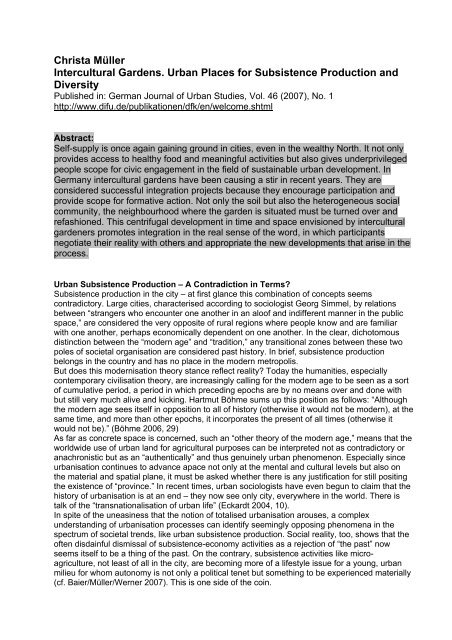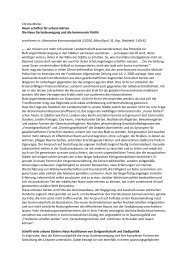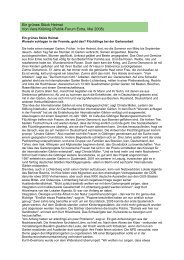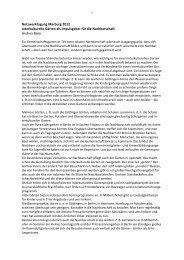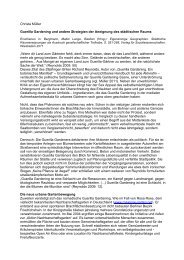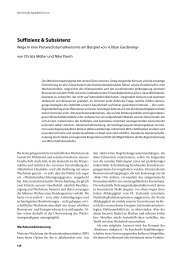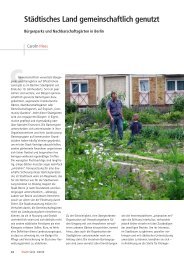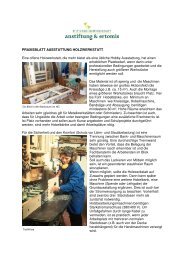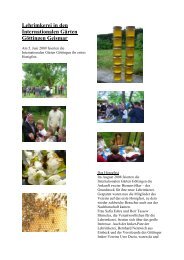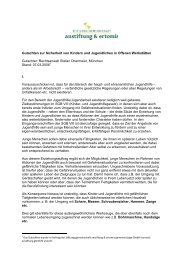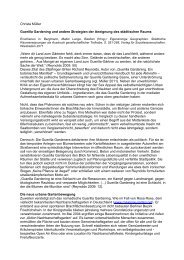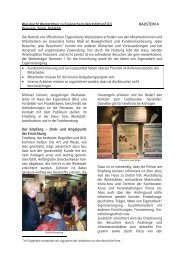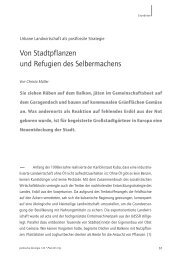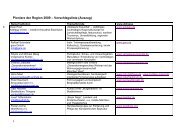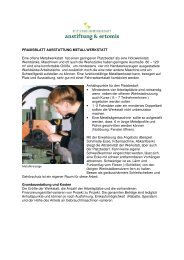Christa Müller - Stiftung Interkultur
Christa Müller - Stiftung Interkultur
Christa Müller - Stiftung Interkultur
You also want an ePaper? Increase the reach of your titles
YUMPU automatically turns print PDFs into web optimized ePapers that Google loves.
<strong>Christa</strong> <strong>Müller</strong><br />
Intercultural Gardens. Urban Places for Subsistence Production and<br />
Diversity<br />
Published in: German Journal of Urban Studies, Vol. 46 (2007), No. 1<br />
http://www.difu.de/publikationen/dfk/en/welcome.shtml<br />
Abstract:<br />
Self-supply is once again gaining ground in cities, even in the wealthy North. It not only<br />
provides access to healthy food and meaningful activities but also gives underprivileged<br />
people scope for civic engagement in the field of sustainable urban development. In<br />
Germany intercultural gardens have been causing a stir in recent years. They are<br />
considered successful integration projects because they encourage participation and<br />
provide scope for formative action. Not only the soil but also the heterogeneous social<br />
community, the neighbourhood where the garden is situated must be turned over and<br />
refashioned. This centrifugal development in time and space envisioned by intercultural<br />
gardeners promotes integration in the real sense of the word, in which participants<br />
negotiate their reality with others and appropriate the new developments that arise in the<br />
process.<br />
Urban Subsistence Production – A Contradiction in Terms?<br />
Subsistence production in the city – at first glance this combination of concepts seems<br />
contradictory. Large cities, characterised according to sociologist Georg Simmel, by relations<br />
between “strangers who encounter one another in an aloof and indifferent manner in the public<br />
space,” are considered the very opposite of rural regions where people know and are familiar<br />
with one another, perhaps economically dependent on one another. In the clear, dichotomous<br />
distinction between the “modern age” and “tradition,” any transitional zones between these two<br />
poles of societal organisation are considered past history. In brief, subsistence production<br />
belongs in the country and has no place in the modern metropolis.<br />
But does this modernisation theory stance reflect reality? Today the humanities, especially<br />
contemporary civilisation theory, are increasingly calling for the modern age to be seen as a sort<br />
of cumulative period, a period in which preceding epochs are by no means over and done with<br />
but still very much alive and kicking. Hartmut Böhme sums up this position as follows: “Although<br />
the modern age sees itself in opposition to all of history (otherwise it would not be modern), at the<br />
same time, and more than other epochs, it incorporates the present of all times (otherwise it<br />
would not be).” (Böhme 2006, 29)<br />
As far as concrete space is concerned, such an “other theory of the modern age,” means that the<br />
worldwide use of urban land for agricultural purposes can be interpreted not as contradictory or<br />
anachronistic but as an “authentically” and thus genuinely urban phenomenon. Especially since<br />
urbanisation continues to advance apace not only at the mental and cultural levels but also on<br />
the material and spatial plane, it must be asked whether there is any justification for still positing<br />
the existence of “province.” In recent times, urban sociologists have even begun to claim that the<br />
history of urbanisation is at an end – they now see only city, everywhere in the world. There is<br />
talk of the “transnationalisation of urban life” (Eckardt 2004, 10).<br />
In spite of the uneasiness that the notion of totalised urbanisation arouses, a complex<br />
understanding of urbanisation processes can identify seemingly opposing phenomena in the<br />
spectrum of societal trends, like urban subsistence production. Social reality, too, shows that the<br />
often disdainful dismissal of subsistence-economy activities as a rejection of “the past” now<br />
seems itself to be a thing of the past. On the contrary, subsistence activities like microagriculture,<br />
not least of all in the city, are becoming more of a lifestyle issue for a young, urban<br />
milieu for whom autonomy is not only a political tenet but something to be experienced materially<br />
(cf. Baier/<strong>Müller</strong>/Werner 2007). This is one side of the coin.
Urban Subsistence Production: Supply Resource, Self-Help, Empowerment<br />
The other aspect of urban subsistence production is its function as a supply resource based on<br />
self-help and empowerment and which in many cities of the world must take on supply functions<br />
the failing state and the just as frequently failing market cannot perform. This is demonstrated by<br />
the thousands of huertas comunitarias in a Buenos Aires torn by crisis and by the several<br />
hundred community gardens in New York City or Toronto (cf. Arndt/Haidle 2004; Rosol/Weiß<br />
2005; Meyer-Renschhausen 2004). For the urban poor – in the metropolises of the South and<br />
North – allotment gardening close to home has also offers an opportunity for obtaining highquality<br />
food.<br />
For example, the community gardens in the Canadian city of Toronto are integrated into a<br />
network of organisations combating hunger. As the Berlin urban planners Marit Rosol and Julika<br />
Weiß have shown in a study, the cause of hunger in Canada is not any scarcity of food but a lack<br />
of money among the growing number of the economically underprivileged. Low wages, high<br />
rents, and massive cutbacks in social security benefits mean that more and more people are<br />
going hungry in one of the richest countries in the world. People with very low incomes pay the<br />
proportionately highest rents – what is left is often insufficient to cover the cost of food.<br />
“Non-profit organisations complain that the poor face the doubtful choice ‘pay the rent or feed the<br />
kids.’ That this is no publicity-grabbing exaggeration is shown by a study conducted by the<br />
Ontario Food Bank Association: 65% of food bank customers spend more than 65% of their<br />
income on rent (Food and Hunger Action Committee 2001)” (Rosol/Weiß 2005, 5).<br />
Community gardens are hence an increasingly important tool in combating hunger. However, the<br />
researchers rightly warn against instrumentalizing them as a substitute for basic social security.<br />
In large cities of the South, too, like Nairobi or Havana, a considerable proportion of the essential<br />
food supply is cultivated in the urban area – for home consumption and specifically to supply<br />
local markets (cf. Bakker et al. 2000). There, as in London and Los Angeles and in innumerable<br />
places around the world, NGOs, as well as local government institutions provide gardeners with<br />
infrastructure, initiate educational activities, network projects, and organise knowledge transfer.<br />
Such institutions, like GreenThumb, a section of the New York Department of Parks and<br />
Recreation, or the USA-wide umbrella organisation American Community Gardening Association,<br />
are outcomes of politicisation of the community garden movement, which began in the 1970s. In<br />
New York it was the vacant lots, often the result of arson, in run-down and written-off parts of<br />
town that became inner-city oases through the engagement of the poor, points of departure for<br />
revitalising neighbourhoods – which paradoxically put them at risk of becoming more interesting<br />
as building land owing to the attractive greenery and social harmony they introduce into the area<br />
(cf. Meyer-Renschhausen 2004, 145 ff.).<br />
Hundreds of New York community gardens were razed and redeveloped at the climax of neoliberal<br />
urban policy in the 1990s. Nevertheless, American urban policy is now unthinkable without<br />
such gardens. All big cities have meanwhile recognised that the gardens not only alleviate<br />
poverty but also bring greenery into urban neighbourhoods, improve air quality, and create room<br />
for civic engagement among the underprivileged.<br />
Intercultural Gardens: Social Spaces for Communication and Integration<br />
In Germany, intercultural gardens have been causing a stir since the mid-1990s. These social<br />
spaces, new in the German project landscape, not only serve urban recreational purposes and<br />
supply organic fruit and vegetables but quite deliberately pursue a further aim: intercultural<br />
communication and integration on the basis of a resource-oriented approach.<br />
It was not by chance that the intercultural garden movement in Germany had its beginnings in an<br />
immigrant centre. In 1995 Bosnian refugees found themselves stranded in Göttingen, awaiting<br />
the end of the war in their home country, women unaccustomed to idleness who missed their big<br />
vegetable gardens. Together with the Ethiopian agrarian engineer Shimeles, they went in search<br />
of suitable land to cultivate even in exile. This was the start of a success story (<strong>Müller</strong> 2002;<br />
Shimeles 2002). The “Intercultural Gardens Network” coordinated by the <strong>Stiftung</strong> <strong>Interkultur</strong><br />
(Intercultural Foundation) has now assembled more than 60 such garden projects in Germany<br />
alone, and about the same number are being developed (status: spring 2007; www.stiftunginterkultur.de)
Intercultural gardens bring together Germans and immigrants – very often with a refugee<br />
background – from all strata of society to cultivate fruit and vegetables, exchange seed and<br />
recipes, build small, wooden community houses and clay baking ovens, cook, organise<br />
barbecues, and celebrate. Working the soil together, which has allowed many to use their<br />
knowledge and abilities for the first time in Germany in an international context, also creates a<br />
field of learning that goes far beyond planting and harvesting garden produce. Especially in the<br />
winter months, the repertoire of a “well assorted” garden extends to language and computer<br />
courses, arts and crafts, sport, theatre workshops, intercultural environmental education,<br />
neighbourhood networking, music, lectures and counselling, many activities for children, further<br />
education in nutrition and gardening, factory tours and excursions.<br />
Intercultural gardens do not look the same as the accustomed, traditional allotment garden areas.<br />
Generally there is at most one garden hut per project, and trimmed hedges or fenced-in plots are<br />
lacking. Discreet boundaries are the rule between the ten to eighty square-metre beds.<br />
Sometimes they are demarcated with shoes, sometime with rope, or, often indiscernibly for<br />
outsiders, only by different species of plant. Fences are rarely erected, only as protection against<br />
rabbits, dogs, and sometimes against young local troublemakers.<br />
Apart from the private plots, all gardens have large common areas with a fireplace, sometimes a<br />
wooden building, playground apparatus, perhaps a site trailer for the children, and, in favoured<br />
areas, even a glasshouse where seedlings can be raised and winter vegetables grown for the<br />
market stand. The common areas are important for communication, for eating and drinking<br />
together, for play, and for the parties to which the gardeners regularly invite guests.<br />
More women than men are to be seen in intercultural gardens. Because gardening is a female<br />
domain in many parts of the world, it is mostly women who take responsibility for the work and<br />
the socialising. They do so in keeping with their own ideas, and this is not the only reason why<br />
women benefit particularly from such gardens. It begins with the use of the German language, a<br />
must because it is the smallest common denominator. Moreover, the gardens offer women and<br />
children an escape from often cramped housing conditions. They are seen as a welcome<br />
extension of living space and scope for enterprise. They not only contribute to the family income.<br />
The gardens are places where one’s own experience, cares and joys can be shared with other<br />
women. Many women can thus build self-confidence, often helping them to hold their own in<br />
family conflicts and to cope with the rapid development of society, which they mostly face in<br />
concentrated form in their children’s consumption of the media.<br />
Not least of all for this reason, many participating parents are happy that intercultural gardens<br />
offer many amenities for children. In many projects, children have their own vegetable and flower<br />
beds. They, too, learn to negotiate about land, to understand complex interactions between<br />
animals, plants, and human beings; they observe the processes of nature and take part in<br />
excursions into the forest, to farms, and to environmental facilities. Like adult activities, child<br />
activities in intercultural gardens are based on personal initiative and on integrating the child’s<br />
knowledge into new fields of experience.<br />
Not only plants grow in the garden. A Göttingen schoolgirl who had grown up in the Göttingen<br />
International Gardens described it as a “a great stroke of luck” that her mother had helped<br />
created this place. It had given her the opportunity to re-constitute her widely scattered family of<br />
origin.<br />
“I was in the garden from the age of about three or four. Just about all the members of the<br />
Göttingen International Gardens are my ‘aunts and uncles.’ It’s like a second home. You see<br />
each other here all the time. When we’re in town, you notice how many people know me, give me<br />
a smile or greet me, or stop for a chat. And most of them know me from the garden.”<br />
International elective affinities not only substitute for family ties, they also enable new insights, for<br />
instance, into what it means for refugees in Germany to be able to supply their own needs, to<br />
give away surplus produce, to be givers and not dependent solely on handouts, to experience<br />
and “squander” abundance instead of always having to manage with meagre resources. At an<br />
early age, the Göttingen schoolgirl learned to taste the difference between homemade and<br />
bought, between high-quality organic vegetables and supermarket goods imported from afar. She<br />
experienced what it means to prepare meals in a public space, she listened to stories about<br />
zucchini and purslane, chickpeas and peppermint, tales from childhood, songs from many home<br />
countries, which blossom anew for a brief moment in the gardens, beautiful songs, sad songs.
What do immigrant children do with themselves if they lack these opportunities? Children who<br />
have the impression their parents have no say in the public sphere? Who see their often<br />
unemployed parents merely awaiting developments, unproductive, not fully occupied? Parents<br />
waiting in vain for their chance in life. What models take root in the minds of these children, and<br />
what value do they place on their origins?<br />
Concern for Others and Other Things<br />
Even if intercultural gardens offer no gainful employment – they at least offer many opportunities<br />
to take care of oneself and others and to contribute to the greater good, for example, to the future<br />
of our cities. Not least of all, the commitment of many intercultural gardens to sustainable urban<br />
development, ecology, and integration, to health and nutrition means that many gardeners<br />
recognise they are working not only for themselves. Thus a Kurdish gardener stated that her<br />
engagement in the association enabled her to do something for others, allowing her to lead a<br />
meaningful life:<br />
“If we think only about industry and making money, that gets us nowhere in the end. We come to<br />
a point where you have everything but it’s no longer a life. Nature is life. I’m proud to be an active<br />
member of an association that takes care of derelict sites and cultivates them instead of this<br />
building, building, building without end. And that, through the work of our members, at least in<br />
summer, we can harvest clean vegetables, not sprayed. That’s very, very important. Most<br />
couldn’t afford organic vegetables and fruit at all otherwise.”<br />
Strengthening Diversity<br />
The gardeners come from all over the world; in some projects more than 20 nationalities are<br />
represented. This diversity is deliberate. The statutes of most garden projects stipulate that as<br />
many national and socio-cultural backgrounds as possible are to be represented to avoid the<br />
cultural dominance of any one group. For one phenomenon is to be observed a every garden: all<br />
would prefer to bring in people close to them – and this often means members of their own ethnic<br />
group.<br />
The monitoring research conducted by the Intercultural Foundation shows that the network now<br />
covers a broad range of organisational forms and characteristics. Each garden project sets its<br />
own main focus. Some concentrate on developing intercultural methods in environmental<br />
education work, other specialise in therapeutic work with traumatised civil-war refugees, others<br />
again focus on vocational training and the development of micro-firms in the fields of horticulture<br />
and catering.<br />
Immigrants do not initiate all projects. Community or church groups, or committed private<br />
individuals often take the initiative. The motives for setting up intercultural gardens also differ<br />
from project to project. In some places it is the wish to resuscitate an old school garden,<br />
elsewhere the desire to create open spaces specially for Muslim women and children, to enjoy<br />
the healing powers of a garden, to provide greenery in a dormitory city, or a place in the city<br />
where people can find an occupation and come together.<br />
As varied as the underlying motives are the forms of organisation, reflecting differences in the<br />
self-conception of the individual projects. Although some of the more recent projects have<br />
learned from the experience of such undertakings as the International Gardens Göttingen with its<br />
grass-roots democratic organisation, each project develops its own form independently. The<br />
spectrum is broad. Some projects first set up a charitable association (the Intercultural<br />
Foundation provides standard statutes in the context of its practical counselling), others emerge<br />
from existing associations or cooperate with such groupings to integrate the intercultural garden<br />
project into the larger organisation. Others initially do without a formal, written framework.<br />
The Approach: Participation and Resource-Orientation<br />
Founding an association usually proves to be the best path. Not only because registration as an<br />
association allows the projects to solicit funds. Registered association status, which endows the<br />
organisation with legal capacity, and the statutes drafted and adoped by garden members<br />
themselves are a guarantee for co-determination and participation, two key “side-effects” of<br />
community gardening. It is usually worth the effort to take the bureaucratic hurdles to setting up a<br />
registered association. Satsisfactory practical experience in many projects with participation,
conflict management, and activation is also a reason why the resource-oriented, socially inclusive<br />
intercultural garden approach has attracted growing attention in the search for convincing<br />
integration concepts.<br />
Germany is a country of immigration. After many years of “wait-and-see,” of ignoring the issue,<br />
this fact has finally filtered through to all sectors of society. Having re-defined itself, the country<br />
now faces the question of how to meet the challenge in concrete terms. What needs to be done<br />
to meet the demands of a plural society? How can growing diversity be recognised, appreciated,<br />
and mediated while repeatedly establishing and promoting elements of a common basis? These<br />
maxims are all the more important in times when it is no longer possible to rely on an institution<br />
that had always played a key role in integration in the past: gainful employment – a life-long<br />
institution that forms identities, provides social security, and a high degree of social inclusion.<br />
The increasing precariousness of formal employment is accompanied by a seemingly opposing<br />
trend: the hitherto scarcely perceived informal life and working worlds that had always existed<br />
alongside the formal markets for labour and goods are now becoming more and more important<br />
for identity formation and for societal inclusion processes. These processes, it must be stressed,<br />
will increasingly affect not only immigrants alone but also a growing section of the population<br />
who, although “native” to the country, are constantly on the brink of exclusion.<br />
Social experience in intercultural gardens shows that it makes sense to develop and test<br />
integration concepts that involve immigrants from the outset on a footing of equality. The focus is<br />
not on keeping people in the “safe custody” of multicultural tearooms or “discussing” the<br />
problems of everyday life but rather on engaging in joint activities and giving shape to the<br />
immediate environs. In the case of gardens, it is the soil that first needs to be turned over and<br />
planted. But shape and vitality must also be given to the heterogeneous social community that<br />
gathers on the terrain – and to the neighbourhood community in which the garden is embedded.<br />
This centrifugal development in time and space promotes integration in the real sense of the<br />
word, in which participants negotiate their reality with others and appropriate the new situations<br />
that arise in the process. Resources in the form of tacit knowledge, social competence, and the<br />
willingness to learn gain a new locus and are modified as they connect up with novel<br />
circumstances, e.g. with the environmental debate in our latitudes. This means that picking up<br />
with the past, with what has been left behind, is subject at the moment of realisation to social<br />
differentiation through integration. The measure for the success of this process is the degree of<br />
involvement without – and here lies the real problem with many “integration measures” –<br />
participants feeling under pressure to abandon their identities as demanded, for instance, under<br />
the assimilation concept.<br />
The task is rather to find new access to one's own identity and to negotiate it with others in a<br />
subtle communication process. Perhaps for this very reason, intercultural gardens are attractive<br />
not only for people with an agricultural background. On the contrary, they attract both former<br />
farmers and urban intellectuals. Such gardens are places where different languages, different<br />
classes, and different political leanings meet. Diversity cannot be reduced to ethnic difference;<br />
conflicts are inevitable. The difficult task facing the projects is to discover common ground. For<br />
this reason, no garden works “of its own accord.” The people who are “thrown together” artificially<br />
in this manner do not get along without further ado. But the framework facilitates the ambitious<br />
plan: to give shape to a piece of land together, to watch something of one’s own grow, and to<br />
compare with others, to exchange views on the growth of plants and about one’s own successes<br />
and failures – these are the big and the small possibilities that a garden offers.<br />
The <strong>Stiftung</strong> <strong>Interkultur</strong> – International Networking and Coordination<br />
In unexpected ways, the idea of intercultural gardens is spreading in Germany, and now in many<br />
countries of Europe. Thus the International Gardens Göttingen were selected in the spring of<br />
2007 by the London Sustainable Development Commission (LSDC) as one of eight international<br />
projects to be studied in the quest for inspiration for the urban policy of the future. In the course<br />
of its monitoring work, the Intercultural Foundation had had intensive contact with Britain at an<br />
early date, with the British Black Environment Network, and with the community gardens<br />
movement in the USA.<br />
Extensive reports in the international, regional, and national press and on television, as well as in<br />
a growing number of academic publications coordinated by the Intercultural Foundation in the
Intercultural Gardens Research Network have focused attention on the micro-worlds of<br />
intercultural gardens. Only a few years after the birth of the idea, there are now local authorities<br />
that propagate and promote intercultural gardens (in Berlin, for example, the Senate has adopted<br />
a measure under which district authorities may designate land and provide start-up equipment<br />
and materials), and Local Agenda groups, environmental associations, urban and landscape<br />
planning authorities, neighbourhood managements, and church organisations such as the<br />
Diakonie and Caritas have discovered the new social spaces.<br />
The Intercultural Foundation, the national coordinating organisation of the Intercultural Gardens<br />
Network advises the actors involved on setting up gardens, provides succinct information on the<br />
experience of other projects, issues news letters, organises knowledge transfer with politics and<br />
science, publishes research results in its own and the specialised media, supports projects<br />
financially, and organises networking meetings and conferences. The Intercultural Foundation is<br />
also currently involved in a European learning partnership under the EU GRUNDTVIG<br />
programme (framework for action under the European educational programme SOCRATES II).<br />
The tremendous growth in public interest is justified. Intercultural gardens have now gained a<br />
trend-setting reputation as far as the consistent application of empowerment and resource<br />
orientation are concerned. Integration effects can be achieved with this method in other contexts,<br />
too. Intercultural gardens encourage participation and endow people with the power for formative<br />
action – these will in the long run prove pillars of an inclusive and plural immigrant society, which<br />
can become a reality only by activating all its members.<br />
References<br />
Arndt, Christoph/Haidle, Isabella (2004): Urbane Gärten in Buenos Aires, Diplomarbeit an der<br />
Technischen Universität Berlin.<br />
Bakker, Nico/Dubbeling, Marielle/Gündel, Sabine, et al. (eds.) (2000): Growing Cities, Growing<br />
Food. Urban Agriculture on the Policy Agenda, Feldafing.<br />
Baier, Andrea/<strong>Müller</strong>, <strong>Christa</strong>/Werner, Karin (2007): Wovon Menschen leben. Arbeit,<br />
Engagement und Muße jenseits des Marktes, München.<br />
Böhme, Hartmut (2006): Fetischismus und Kultur. Eine andere Theorie der Moderne, Reinbek.<br />
Eckardt, Frank (2004): Soziologie der Stadt, Bielefeld.<br />
Meyer-Renschhausen, Elisabeth (2004): Unter dem Müll der Acker. Community Gardens in New<br />
York City (ed. by <strong>Stiftung</strong> Fraueninitiative), Königstein/Ts.<br />
<strong>Müller</strong>, <strong>Christa</strong> (2001), Women in the International Gardens: How Subsistence Production Leads<br />
to New Forms of Intercultural Communication, in: Bennholdt-Thomsen, V./Faraclas, N./v.<br />
Werlhof, C. (eds.): There is an Alternative. Subsistence and Worldwide Resistance to Corporate<br />
Globalization. London, p. 189-201.<br />
<strong>Müller</strong>, <strong>Christa</strong> (2002): Wurzeln schlagen in der Fremde. Die Internationalen Gärten und ihre<br />
Bedeutung für Integrationsprozesse, München.<br />
<strong>Müller</strong>, <strong>Christa</strong>/Werner, Karin (2003): <strong>Stiftung</strong> <strong>Interkultur</strong>. Ein neues Modell für ökologische und<br />
transkulturelle Kooperation, in: Elsner, W./Biesecker, A. (eds.): Neuartige Netzwerke und<br />
nachhaltige Entwicklung. Komplexität und Koordination in Industrie, Stadt und Region,<br />
Frankfurt/M., 309–323.<br />
Rosol, Marit/Weiß, Julika (2005): Community Gardens in Toronto und Seattle – interkulturell,<br />
ökologisch und ernährungssichernd, München (SI-Skripte zu Migration und Nachhaltigkeit Nr. 1).<br />
Shimeles, Tassew (2002): Projekt Internationale Gärten. Ein Beitrag für sozialen Frieden, in:<br />
Orth, Gottfried (Hrsg.): Die Erde – lebensfreundlicher Ort für alle. Göttinger Religionsgespräch<br />
2002 zur Umwelt- und Klimapolitik, Münster, 79–88.<br />
Simmel, Georg (1992, 1st ed. 1908): Soziologie. Untersuchung über die Formen der<br />
Vergesellschaftung, Frankfurt/M.


